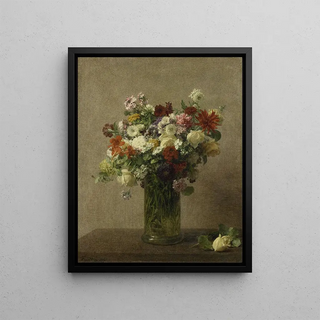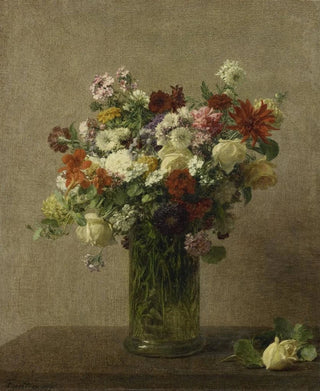Art print | Fleurs de Normandie - Henri Fantin-Latour


View from behind

Frame (optional)
Art print Fleurs de Normandie - Henri Fantin-Latour – Engaging introduction
In the captivating world of floral art, "Fleurs de Normandie" by Henri Fantin-Latour stands out for its elegance and delicacy. This piece, imbued with timeless beauty, transports us to the heart of a lush garden where nature flourishes in all its splendor. Gazing at this composition, the viewer is invited to immerse themselves in a world of vibrant colors and harmonious shapes, showcasing the artist's exceptional talent. The flowers, depicted with remarkable precision, seem to vibrate under the light, evoking both the fragility and strength of life. It is an invitation to contemplation, poetry, and wonder.
Style and uniqueness of the work
Fantin-Latour's style is characterized by a realistic approach, but also by an impressionist sensitivity unique to him. In "Fleurs de Normandie," each petal is treated with meticulous detail, revealing the texture and nuances of each flower. The color palette chosen by the artist is both rich and subtle, oscillating between vivid tones and pastel shades, creating an atmosphere of serenity and freshness. The carefully orchestrated play of light adds an almost tactile dimension to the piece, allowing the viewer to feel the scent of the flowers and the softness of a spring breeze. This singularity makes the work not only a tribute to nature but also an exploration of human emotions, where each flower tells a story.
The artist and his influence
Henri Fantin-Latour, a prominent figure of the 19th century, is recognized for his ability to capture the ephemeral beauty of nature. Influenced by the Romantic movement and the beginnings of Impressionism, he developed a style that is uniquely his own, blending realism and emotion. His passion for flowers, often depicted in his works, reflects a fascination with natural beauty and the fragility of existence. Fantin-Latour also maintained close connections with other artists of his time, such as Claude Monet and Édouard Manet, contributing to the evolution

Matte finish

View from behind

Frame (optional)
Art print Fleurs de Normandie - Henri Fantin-Latour – Engaging introduction
In the captivating world of floral art, "Fleurs de Normandie" by Henri Fantin-Latour stands out for its elegance and delicacy. This piece, imbued with timeless beauty, transports us to the heart of a lush garden where nature flourishes in all its splendor. Gazing at this composition, the viewer is invited to immerse themselves in a world of vibrant colors and harmonious shapes, showcasing the artist's exceptional talent. The flowers, depicted with remarkable precision, seem to vibrate under the light, evoking both the fragility and strength of life. It is an invitation to contemplation, poetry, and wonder.
Style and uniqueness of the work
Fantin-Latour's style is characterized by a realistic approach, but also by an impressionist sensitivity unique to him. In "Fleurs de Normandie," each petal is treated with meticulous detail, revealing the texture and nuances of each flower. The color palette chosen by the artist is both rich and subtle, oscillating between vivid tones and pastel shades, creating an atmosphere of serenity and freshness. The carefully orchestrated play of light adds an almost tactile dimension to the piece, allowing the viewer to feel the scent of the flowers and the softness of a spring breeze. This singularity makes the work not only a tribute to nature but also an exploration of human emotions, where each flower tells a story.
The artist and his influence
Henri Fantin-Latour, a prominent figure of the 19th century, is recognized for his ability to capture the ephemeral beauty of nature. Influenced by the Romantic movement and the beginnings of Impressionism, he developed a style that is uniquely his own, blending realism and emotion. His passion for flowers, often depicted in his works, reflects a fascination with natural beauty and the fragility of existence. Fantin-Latour also maintained close connections with other artists of his time, such as Claude Monet and Édouard Manet, contributing to the evolution






